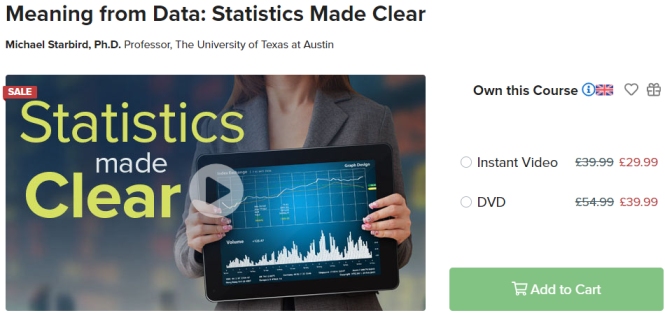Description
Course Meaning from Data: Statistics Made Clear. Who was the greatest baseball player of all time? How likely is the poll to be correct? Is it smart to buy last year’s highest performing stocks? Which hospital has the best results for a particular procedure? When is it a good idea to buy an extended warranty on a product? These questions all involve the interpretation of statistics, as do a surprising number of other mysteries, including: Is the “hot hand” among sports players real? How can you tell if Shakespeare is the likely author of a newly discovered poem? What is the guilt-free way for someone to confess to infidelity? and how a tax assessor calculates the market value of a home he does ?
The Meaning of Data: Statistics Made Clear is an introduction to a very important topic in today’s data-driven society. In 24 half-hour lectures, you will explore the principles and methods that underlie the study of statistics. Possibly terms like mean, median, percentile, quartile, statistical significance And bell curve have heard and you may have a rough idea of their meaning. This course will sharpen your understanding of these and a host of other statistical concepts and show how they can be used correctly to extract meaning from data.
Get statistically savvy: These challenging yet accessible lectures take no background in mathematics beyond basic algebra. While most introductory college statistics courses emphasize solving technical problems and adding data to formulas, this course focuses on the logical foundations and fundamental strategies of statistical reasoning, illustrated with many examples. Professor Michael Starbird guides you through the most important equations, but his emphasis is on the role of statistics in everyday life, giving you an overview of how statistical tools can be used in risk assessment, university admissions, drug testing, fraud investigation and hosting. from other applications
Statistical Adventures: Professor Starbird is a master at conveying concepts through examples. Some of these are:
- When is the lottery not a draw? When it’s not really random. The 1969 Vietnam War draft lottery assigned draft-age young men an induction rating based on their birthday, placed in capsules and drawn from a container, apparently at random. But by calculating the statistical correlation for the order of draws, it becomes clear that a non-random variable is at play. The most likely explanation is that the capsules were not thoroughly mixed with the dates.
- Birthday challenge: What is the probability that out of 50 random people, two of them have the same birthday? Chances are much higher than most people think.
- Chicken soup method: How can 1,000 randomly selected people predict the behavior of hundreds of millions of voters? This is the nature of a political poll, and its effectiveness should be no more surprising than the fact that a taste of chicken soup is enough to predict the overall salinity of the batch, whether that batch is in a cup or a giant pot. .
- Beware of fallacious reasoning: In the OJ Simpson murder trial, Simpson’s attorney Johnnie Cochran countered evidence that Simpson beat his wife with the statistic that only 1 in 1,000 battered women go on to kill their spouses. Therefore, Cochran argued, there was only a 1 in 1,000 chance that Simpson would go on to kill. Professor Starbird discusses the fallacies of this argument, including that the wife in this case was actually murdered, so the relevant question should be: What is the probability that she was already beaten?
- Who Really Won the 1860 Presidential Election? Establishing the will of the people in an election can be difficult, especially when there are three or more candidates involved. Professor Starbird shows how the results of the four-way presidential race of 1860 can be interpreted as victories for each of the three candidates, depending on the voting scheme used. Abraham Lincoln won under the existing rules, but under other equally valid rules, the victor – and the history – would have been very different.
Statistics are everywhere: Statistical information is truly everywhere. You can’t look at a newspaper without seeing statistics on almost every page. You can’t talk about weather forecasting without citing statistics. Statistics most obviously arise in business and the social sciences, but even enter the arts in the analysis of manuscripts. And it is better not to go to the casino without understanding the statistics. “Finding where statistics don’t matter,” says Professor Starbird. It’s really harder than finding the places where they are
What you will learn in Meaning from Data: Statistics Made Clear course
- bell curve
- Distribution models – well-formed families
- Democracy and the impossibility of the arrow
- Describing data and inferring meaning
- And…
Course details Meaning from Data: Statistics Made Clear
Course titles Meaning from Data: Statistics Made Clear
Course images
Sample video of the course
Installation guide
After Extract, view with your favorite Player.
Subtitle: None
Quality: 480p
download link
File(s) password: www.downloadly.ir
Size
10.6 GB
